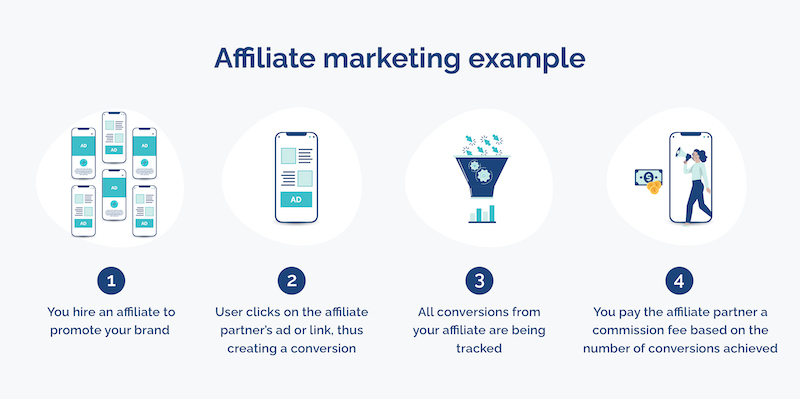In the digital marketing world, affiliate marketing is considered one of the most successful in driving sales and generating revenue — which explains why 80% of advertisers run some type of affiliate marketing program.
However, the more lucrative the marketing method, the more fraudsters find ways to exploit it for their own gain. And since affiliate marketing is such an effective marketing method, it is also highly susceptible to fraud, causing huge dents in advertiser budgets.
Paying publishers and affiliates commission when they create legitimate value for you doesn’t hurt. But it does hurt to pay those who abuse your campaigns and drain your budgets.
So, what can you do to protect your organization from affiliate marketing fraud? In this article, we’ll explore:
- What affiliate marketing fraud looks like
- The 5 most common types of affiliate marketing fraud
- The impacts of affiliate marketing fraud
- 4 Affiliate marketing fraud indicators
- How you can prevent affiliate marketing fraud
What is affiliate marketing fraud?
Before we dive into what affiliate marketing fraud is, let’s take a look at affiliate marketing itself.
What is affiliate marketing?
Affiliate marketing consists of performance-based marketing programs. This means that the partners — usually the affiliates themselves — are paid a commission by advertisers for traffic, marketing leads, or sales generated from their referrals.
Aside from traffic and sales, and depending on the merchant or advertiser, the desired affiliate marketing results can also be actions such as completed lead forms, newsletter subscribers, or free trial users.
Affiliate marketing is popular since it can be used across a multitude of channels, such as blogs and websites, YouTube videos, and email campaigns. A common example of affiliate marketing occurs when websites link out to (or “refer”) specific product pages in a product review using a unique link. If a customer clicks this link and purchases the product via this link, the affiliate will earn a commission.

How does affiliate marketing fraud work?
Affiliate marketing fraud occurs when fraudsters fake conversions such as clicks, visits, lead captures, subscriptions, or even app installs. These fake events lead to click fraud, lead fraud, subscription fraud, and install fraud.
All of these methods not only undermine advertisers’ confidence in their affiliates, but they waste budgets, too.
There is no one type of affiliate marketing fraud. In fact, there are several ways fraudsters can exploit affiliate marketing programs, whether they’re based on CPM (cost-per-mille), CPC (cost-per-click), CPL (cost-per-lead), or CPA (cost-per-acquisition) payment models.
5 Most common types of affiliate marketing fraud
Well-versed in exploiting ad campaigns, fraudsters use several ad fraud techniques to carry out affiliate marketing fraud. Depending on the type of affiliate marketing programs you engage in, your organization could be vulnerable to one or many of these methods. Below, we explore the most common types of affiliate marketing fraud and the vehicles fraudsters use to perform them.
Types of affiliate marketing fraud
Click fraud
Click fraud is a popular ad fraud technique whereby fraudsters click on PPC (pay-per-click) ads with no intention of learning more about or purchasing a business’s products or services.
In affiliate marketing, however, it’s not always typical fraudsters who carry out click fraud. In fact, individuals themselves repeatedly click on their own affiliate links to inflate their payout. Other times, competitors will repeatedly click on affiliate links in order to drain their competitor’s advertising budgets.
This serves as a good reminder that affiliate marketing fraud, and ad fraud in general, is not always carried out by ‘professional’ fraudsters. Anyone with access to a digital device can also exploit your campaigns.
Lead fraud
Lead fraud occurs when fraudsters create fake leads to capture money. This can also help inflate a company’s ROI from its online and affiliate marketing campaigns. However, these fake and fraudulent leads will never come to fruition as real customers, wasting your resources.
Impression fraud
Impression fraud happens when ads are invisible to the human eye, yet the impressions are still counted. The most common forms of impression fraud are pixel stuffing and ad stacking.
For example, although users are unaware, when fraudsters stuff pixels (obscure illegitimate pixels) they are effectively viewing multiple ads on one page. Fraudsters then receive compensation for the fraudulent impressions from the stuffed ads.
Install fraud
Install fraud is a type of fraud used to generate fake downloads and installs. Fraudsters perform install fraud in a number of ways using device farms, emulators, and bots. No matter which vehicle is used, marketers end up unknowingly using their ad spend for installs that are not legitimate.
Vehicles used to perform affiliate marketing fraud
Click farms
Click farms represent click fraud on a much larger scale. These farms are made up of tens, hundreds, or thousands of low-paid workers whose job is to manually click on online ads and links and fill in lead forms. Since they’re real humans, click farms are generally difficult to detect.
Domain spoofing
Domain spoofing occurs when bad actors pretend to be quality publishers, despite being low-quality fraudsters. They do this in order to trick advertisers into believing that their affiliate ads are being displayed on trustworthy, quality websites.
In reality, fraudsters create web domains that closely resemble other reliable websites where the impressions and/or clicks on affiliate links appear truly valuable.
Cookie stuffing
To perform cookie stuffing, fraudsters load modified cookies onto user’s web browsers, which misattributes traffic to the fraudster instead of the genuine user when this user purchases the product or service through the affiliate link. Since the fraudster did not do anything to promote the advertiser, the advertiser ultimately wastes affiliate ad spend on fraudulent clicks.
Bots
Bad bots run in the background of users’ devices to imitate real-user behavior and generate fake clicks, impressions, and leads on an automated basis. They’re also used to redirect traffic to affiliates, and by using cookie stuffing, are able to steal commission away from legitimate affiliates.
Malware
Malware — which consists of programs such as spyware and pop-ups — is often installed on users’ devices without their knowledge or permission. Via this malware, fraudsters can then click ads, fill in forms, and perform various other nefarious acts via the user’s device.
What are the impacts of affiliate marketing fraud?

Ad fraud is a huge pain point for organizations that rely on affiliate marketing to bring in large amounts of traffic and sales. Although affiliate marketing fraud allows fraudsters to cash in on commission payouts, there are several other equally damaging impacts.
Loss of confidence in affiliate marketing
Any type of ad fraud can wear advertisers’ patience thin. The same is true of affiliate marketing fraud. When campaigns are ruined by fraudsters, advertisers see diminishing returns and their efforts squandered. This can lead them to become disillusioned and stray away from using affiliate marketing as a solid, effective, and reliable strategy.
Exhausted budgets
Of course, one of the most damning effects of affiliate marketing fraud is the loss or exhaustion of campaign budgets. Advertisers are wrongfully charged for fraudulent activity, without any benefit to show for it.
Fraudsters are capable of ramping up efforts to exploit campaigns at an alarming rate using bots and click farms, meaning that ad budgets can quickly run out when there is no protection in place.
Skewed campaign data
The success of an advertising campaign — namely the number of clicks, leads, and impressions generated — almost always directs future strategy.
However, when a campaign is affected by affiliate marketing fraud, the data resulting from this campaign is also tainted. This means that any decisions based on this data will often lead to advertisers allocating funds and efforts to the wrong places.
It can also result in advertisers pulling an affiliate marketing campaign due to what they see as disappointing results. In reality, the campaign’s conversion rate or other goals were actually fruitful.
Unattainable targets
When we put all of the above impacts together, the natural result is that it becomes extremely difficult for organizations to hit their targets. This can not only devastate campaigns, but entire organizations, depending on their size.
4 Indicators of affiliate marketing fraud
There are many tell-tale signs that affiliate marketing fraud has impacted or is still impacting your campaigns. Here, we go through four of the most notorious indicators of affiliate marketing fraud.
Unexpected campaign improvements
Unfortunately, sudden major campaign performance improvements can often be a sign of affiliate marketing fraud. Especially, if you or your affiliate marketing partner haven’t made any significant changes to your campaigns.
This can look like a sudden increase in the number of impressions during a branding campaign or an unexpected surge in leads in a lead gen campaign.
Thus, upticks in campaign performance should always be monitored and investigated to make sure that the performance is due to legitimate user activity.
Low lifetime value (LVT)
This advertising metric can help you pinpoint any affiliate marketing fraud activity. For example, if signups to your product don’t match the in-product activity, then fraud might be at play.
Unexpected conversion rates
Lots of traffic with few conversions are not always a sign of affiliate marketing fraud. In fact, this combination is the bane of most advertisers’ lives. This could be due to the offer being unclear, misleading ad banners, or faulty CTA buttons.
However, it can also indicate that your campaigns have been targeted by fraud in general.
Similarly, normal traffic with higher conversion rates (where the bottom of the marketing funnel is being compensated with leads or installs) can also be an indicator of fraud.
Spikes in traffic from unusual locations
For instance, if your organization is based in France and your affiliate marketing campaigns target French-based users specifically, then a sudden surge in visitors from outside of this geography might indicate that ad fraud is at play.
How can you prevent affiliate marketing fraud?
Preventing ad fraud is not a one-person or one-system job. To avoid affiliate marketing fraud (or any other type of fraud!), it’s up to every organization to make sure that they have a robust fraud prevention function in place.
This includes not only putting a task force in place made up of relevant individuals (those from the marketing, finance, operations, and product teams) but also means having the right anti ad fraud solutions in place to fight fraud effectively.
Don’t wait for fraudsters to wreak havoc on your affiliate marketing efforts. Too often, advertisers wait until it’s too late to put a stop to their nefarious practices.
Being proactive is the only way to truly protect your campaigns, your efforts, and your budget. Anti ad fraud solution Opticks can help you stop affiliate marketing fraud in its tracks efficiently, long before fraudsters can benefit from the money you’ve invested.
We’re skilled in not just pinpointing affiliate marketing fraud, but putting protections in place to stop it from affecting your campaigns in the first place.
To learn more about how Opticks can shield your organization from ad fraud — leaving you to focus on attaining your business objectives — click here to contact us and book a demo or start your free trial.
